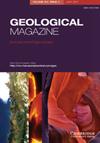法国黑山地区中图尔纳期(密西西比期)缺氧事件期间的弱间歇缺氧
IF 2
3区 地球科学
Q3 GEOSCIENCES, MULTIDISCIPLINARY
引用次数: 2
摘要
摘要Lydiennes组的Tournaisian中期黑色放射虫燧石暴露在法国南部Noire Monta Peyroux Nappe地区Puech de la Suque和Col des Tribes地区的深陆架序列中。该层段代表图尔奈期中期缺氧事件,也称为下明矾页岩事件。这一事件与全球海侵有关,其特征是生产力的提高和从远洋碳酸盐沉积到世界许多地区广泛沉积的富含有机物的黑色硅质页岩和放射虫的剧烈相变化。在本研究中,采用了高分辨率无机地球化学和锤状黄铁矿分析来解读黑蒙塔涅图尔奈期中期缺氧事件期间沉积条件的变化。结果表明,与下明矾页岩事件有关的沉积物的总有机碳含量在0.09-1.9wt%之间。这些低至中等的总有机碳含量、高U/Th、低Corg/P和中等V/Cr比率、氧化还原敏感微量元素(如U、Mo和V)的富集,以及不同大小的黄铁矿碎屑,表明在所研究沉积物的沉积过程中,底层水条件周期性地缺氧。在本研究中,在蒙塔涅-诺伊尔的图尔奈期中期深水海洋序列中也报告了异常汞峰值(>500 ppb),这证实了在这种环境转换过程中区域火山活动增加的可能影响。本文章由计算机程序翻译,如有差异,请以英文原文为准。
Weak and intermittent anoxia during the mid-Tournaisian (Mississippian) anoxic event in the Montagne Noire, France
Abstract The mid-Tournaisian black radiolarian cherts of the Lydiennes Formation are exposed in deep-shelf successions of the Puech de la Suque and Col des Tribes sections of the Mont Peyroux Nappe area in the Montagne Noire, southern France. This interval represents the mid-Tournaisian anoxic event that is also termed the Lower Alum Shale Event. This event is associated with a global marine transgression that was characterized by increased productivity and drastic facies changes from pelagic carbonate sedimentation to the widespread deposition of black organic-rich siliceous shales and radiolarites in many parts of the world. In the present study, high-resolution inorganic geochemistry and framboidal pyrite analyses were employed to decipher changes in depositional conditions during the mid-Tournaisian anoxic event in the Montagne Noire. The results show that the total organic carbon contents of sediments associated with the Lower Alum Shale Event vary from 0.09 to 1.9 wt %. These low to moderate total organic carbon contents, high U/Th, low Corg/P and intermediate V/Cr ratios, enrichment in redox-sensitive trace elements, such as U, Mo and V, as well as varying sizes of pyrite framboids, indicate periodic dysoxic to anoxic bottom-water conditions during deposition of the studied sediments. Anomalous Hg spikes (>500 ppb) are also reported in the mid-Tournaisian deep-water marine succession of the Montagne Noire in the present study, which confirm a possible influence of increased regional volcanic activity during this environmental turnover.
求助全文
通过发布文献求助,成功后即可免费获取论文全文。
去求助
来源期刊

Geological Magazine
地学-地球科学综合
CiteScore
4.70
自引率
0.00%
发文量
111
审稿时长
3 months
期刊介绍:
Geological Magazine, established in 1864, is one of the oldest and best-known periodicals in earth sciences. It publishes original scientific papers covering the complete spectrum of geological topics, with high quality illustrations. Its worldwide circulation and high production values, combined with Rapid Communications and Book Review sections keep the journal at the forefront of the field.
This journal is included in the Cambridge Journals open access initiative, Cambridge Open Option.
 求助内容:
求助内容: 应助结果提醒方式:
应助结果提醒方式:


